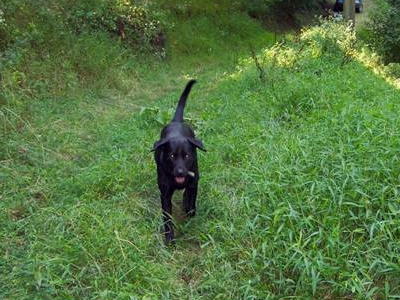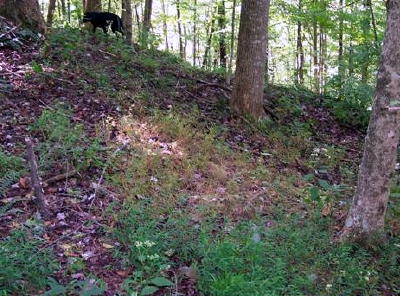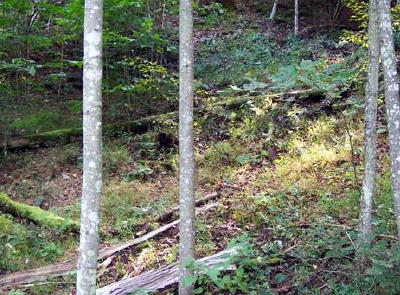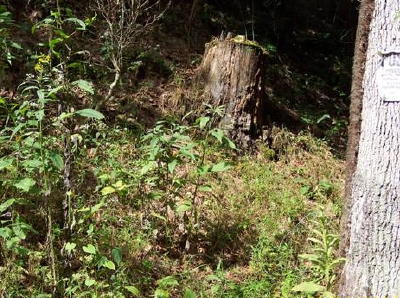DISEASE OF UNKNOWN ORIGIN KILLING JAPANESE STILTGRASS(09/15/2009) - originally appeared in THE HUR HERALD (WV) |
| Article and photos By Russ Richardson During the past fifteen years the introduced weed Japanese Stiltgrass has spread across the region to become one of the most serious problems impacting the long term health and productivity of our native woodland. Late this summer, a still unidentified Stiltgrass disease has become more widespread and it was recently confirmed by researchers at Indiana University. So far, the disease has been confirmed in Calhoun, Roane and Lincoln Counties, West Virginia. Stiltgrass grows very thickly and produces a heavy thatch when it dies in the fall. It is extremely flammable and very slow to rot. It is a very coarse grass that is not very palatable, not sought after or eaten by deer, cows, horses, sheep or goats. 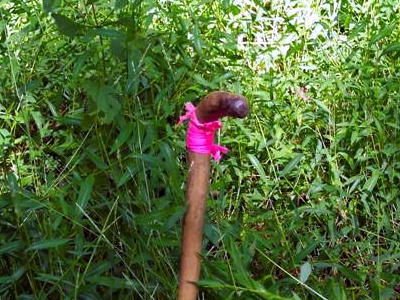 Healthy Stiltgrass can easily grow to be between
Almost any local timberland that has been logged Because of the rapid growth and spread of stiltgrass and the combination of environmental problems that follow an invasion, it has become one of the most studied weeds in the country. There is increasing evidence that Stiltgrass plants may change forest soils in ways that benefit stiltgrass survival. It is now viewed as a very serious threat to the long term health and productivity of our natural hardwood forest. 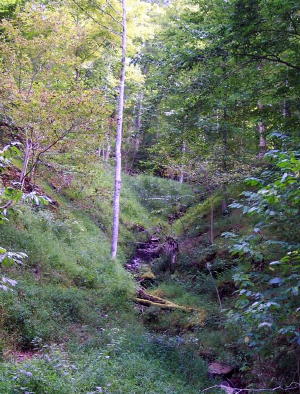 Studying a fertile site in a typical Roane County woodlot, Japanese stiltgrass control is very difficult, producing heavy amounts of seed with rapid spreading. 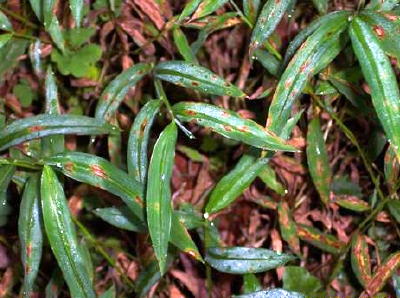 During the summer of 2008 scattered stiltgrass patches in the area
Late in the summer of 2009, the still unidentified stiltgrass disease has become more widespread and it was recently confirmed by researchers at Indiana University as sickening plants in Indiana and the WV Department of Agriculture has found the disease in Lincoln County. The yellow vegetation in the middle of the photo is a patch of dying stiltgrass. Nearly all the stiltgrass on a few acres of this property is sick, diseased or dying.
Dead and dying stiltgrass in Roane County woodland. A few weeks ago the logs on the ground were completely obscured by tall, healthy stiltgrass.
The Calhoun County white oak stump in the middle of this The stiltgrass disease has an unknown origin and it is yet to be found whether it is related to any known illness or disease in our native plants. Samples of diseased plants have been sent to both WVU and Indiana University and researchers are working to identify the disease. Because so little is known about the disease and its origin and whether it is a virus, fungus or bacteria, or whether it has the potential to become valuable as a tool in Stiltgrass control. However, the discovery and confirmation of something killing Japanese Stiltgrass has excited botanists, conservationists and ecological researchers across the country. If local property owners have noticed stiltgrass plants dying they are encouraged to call the WV Department of Agriculture in Charleston at 304-558-2212 to report the mortality. |
Monday, September 21, 2009
BREAKTHROUGH ON JAPANESE STILTGRASS?
Thursday, September 17, 2009
2009 FARMABLE WETLANDS PROGRAM UPDATE
- Includes farmed and prior converted wetlands that have been impacted by farming activities. Must be cropland planted to an agricultural commodity three of the 10 most recent crop years and be physically and legally capable of being planted in a normal manner to an agricultural commodity;
- Include a constructed wetland developed to receive flow for a row-crop agriculture drainage system for the purpose of providing nitrogen removal and other wetland functions;
- Devoted to commercial pond-raised aquaculture in any year during 2002-2007; and
- Cropland that, after Jan. 1, 1990, and before Dec. 31, 2002, was cropped during at least three of 10 crop years, and was subject to the natural overflow of a prairie wetland.
- Enrolled land cannot exceed:
- 40 acres for wetlands or constructed wetlands
- 20 acres for intermittently flooded prairie wetlands
- 40 acres per tract for eligible wetlands and buffers; and
- Participants must agree to restore the hydrology of the wetlands to establish vegetative cover, which may include emerging vegetation in water, bottomland hardwoods, cypress and other appropriate tree species; and to the general prohibition of using the enrolled land for commercial purposes.
- Annual rental payments for a 10- to 15-year period. The rental rate is based on the weighted average dryland cash rent.
- For aquaculture, if there is no soil survey data, annual rental payments are based on the country average CRP rental rate.
- Upfront CRP signing incentive payment of $100 per acre. (This one-time payment is made after the contract is approved and all payment eligibility criteria are met.)
- Practice incentive payment equal to 40 percent of the eligible costs of installing the practice. This one-time payment is made after the practice is installed, eligible costs are verified, and other payment eligibility criteria are met.
- Incentive amount equal to 20 percent of the weighted average dryland cash rent.
- Up to 50 percent cost-share for establishing permanent cover.
Wednesday, September 9, 2009
USDA's Farm Service Agency Accepting Applications for New Biomass Crop Assistance Program
EAST LANSING, Michigan September 8, 2009 - USDA Farm Service Agency State Executive Director Christine White announced that biomass conversion facilities can begin signing up to participated in the Biomass Crop Assistance Program (BCAP), which will help increase the production of renewable energy. The program, authorized by the 2008 Farm Bill, provides financial assistance to producers who deliver eligible material to approve biomass conversion facilities. FSA will provide financial assistance to collect, harvest, store and transport eligible materials.
"This program will benefit producers, the developing biomass industry, the general public and the environment as we continue working to expand production and availability of renewable energy," said White. "Owners of eligible material can receive financial assistance for delivering qualified biomass to approved conversion facilities that use biomass for heat, power, bio-based products or advanced biofuels."
Once an agreement is signed between FSA and a facility, and funding through the program is provided, the facilities can begin accepting eligible materials. Producers who sell these materials can apply for matching payments under the collection, harvest, storage and transportation (CHST) component of BCAP.
The matching CHST payments are paid at a rate of $1 for $1 per dry-ton equivalent received from a qualified biomass conversion facility, not to exceed $45 per dry-ton equivalent. A biomass owner is eligible to receive payments for two years. The purpose of the matching payments is to assist biomass producers with the CHST cost of delivering biomass to a qualified biomass conversion facility.
For example, if a qualified biomass conversion facility pays a producer $30 per dry ton for biomass, the material owner or producer would be eligible for a matching payment of $30 per dry ton from FSA. This payment will help offset the costs of CHST.
Biomass conversion facilities may become "qualified" by submitting a Memorandum of Agreement (MOA) to the FSA state offices. The MOA generally provides the requirements for becoming a qualified biomass conversion facility. Once a facility becomes qualified, eligible material owners or producers who deliver biomass to that facility may be eligible to receive CHST payments.
An application must be submitted before the eligible material is sold and delivered to a qualified biomass conversion facility. After the product is delivered, a producer must provide FSA with documentation of product quantity, quality and payment rate. County offices will validate payment requests with information in the county office and information provided under the terms of MOAs with the qualified biomass conversion facilities. CHST payments will not be authorized until after an appropriate environmental analysis has been conducted.
Biomass conversion facilities and material owners should contact their FSA local offices or visit www.fsa.usda.gov for more information.

